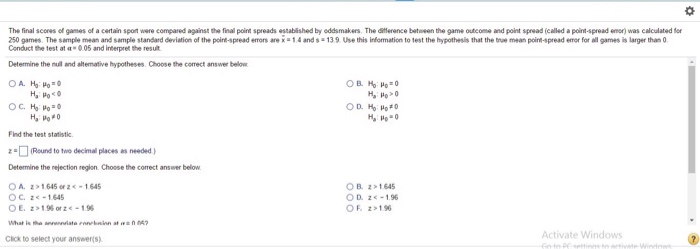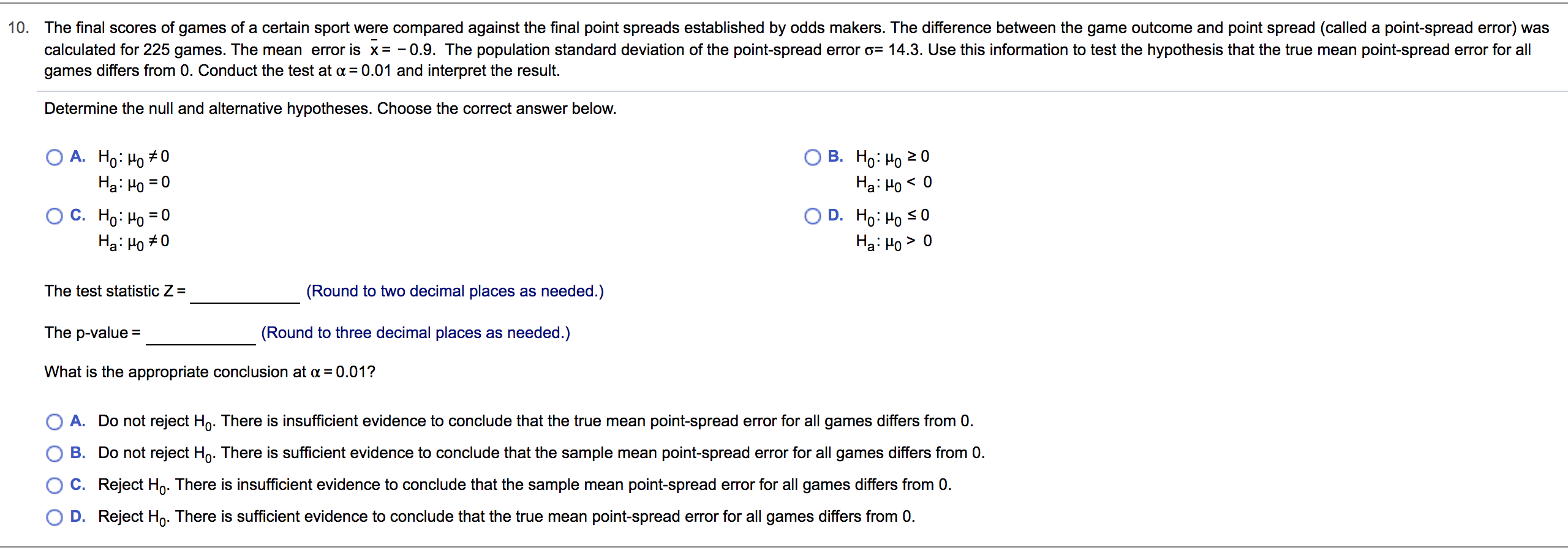What Does Alternative Point Spread Mean
Point spread betting is the most popular form of sports betting. The vast majority of sports wagers use a point spread thanks to the popularity of football and basketball. Even though this type of betting is so popular, it may take awhile to understand.
The point spread is sometimes known as an equalizer for sportsbook operators. All teams aren’t created equally, so sportsbooks can create a point spread for a game so that each team playing has an almost even chance of winning the game. In a way, the point spread will even the field for both teams.
The point spread gives a reason for bettors to risk money on both teams. The better team playing in the game is considered favorite. They have to win by the point spread offered by the sportsbook. The favorite in a game is listed as being minus (-) the point spread.
What does this all mean? Well, the first column is who you are betting on. The second column is the point spread, and the third column is the payout. Let’s look at each bet line by line and talk about what would happen in several different outcomes. The standard “alternative line” is just an extension of the original point spread listed for a particular game. With the spread set at 2.5 points, a bet on the Cowboys would mean that they would have to win by more than 2.5 points (3 or more) in order for you to win that bet. A bet on New York would mean that the Giants would have to either lose by 2.5 or less points (2 or less). The point spread is one of the most popular bets in sport and week in – week out there is a lot of talk about the spread, and where it should be. Here you’ll see what the point spread is and how it is worked out, followed by an explanation of betting the point spread.

The worse of the teams playing in the game is called the underdog. The bettor wins if this team wins the game outright or loses by an amount smaller than the point spread. The underdog in a game is listed as being plus (+) the point spread.
Let’s use this past Super Bowl between the Tampa Bay Buccaneers and Kansas City Chiefs as an example.
Using this example, the Chiefs were 3-point favorites over the Buccaneers. The Chiefs needed to win by 4 or more points to cover the spread.
Likewise, the Buccaneers were 3-point underdogs. That means the Buccaneers needed to win the game outright or not lose the contest by 4 points or more. At Chiefs -3, if they won by exactly 3 points, the betting result would have been a “push” and bettors for both sides would have gotten their wagers refunded.
The Buccaneers pulled off the upset, winning by a score of 31-9, and rewarded bettors who backed them at +3.
Point spread betting odds
Point spreads are usually set with -110 odds, but pricing often fluctuates at online sportsbooks. This is the sportsbook operators’ house edge. The odds guarantee the sportsbook operator will see a little money over time. When the odds are set at -110, the bettor must wager $110 to win $100 (or $11 to win $10).
The odds on a point spread are most commonly known as the vigorish or “vig” for the sportsbook. You might hear this small profit margin for the sportsbook called the “juice” by some sports bettors.
Point spread FAQs

What does ‘pick em’ or ‘pick’ mean in NFL betting?
A “pick em” (sometimes seen as “pick”) is when the teams have a point spread of zero, meaning neither team is favored. In this instance, you’re essentially picking moneyline and your bet will be determined on the winner alone.
What does -7 and +7 mean in NFL betting?
A spread of minus-seven (-7) means that a is favored to win the game by a touchdown (technically, a touchdown and the extra point). A team favored by -7 must win the game by eight or more points to win the bet. If the team wins by seven, the result is a “push” and the bet is refunded.
A spread of +7 means the team must win the game or lose by fewer than seven points to win the bet. A loss by seven would result in a push.
What does -3 and +3 mean in NFL betting?
A -3 spread means that the favorite must win by more than a field goal to win the wager. A three-point win would result in a push and the sportsbook would refund the wager.
A spread of +3 means the team listed as the underdog must win the game or lose by fewer than three points to cash the bet. A three-point loss would be graded as a push by the sportsbook and the bet would be refunded.
Why are point spreads in the NFL so much lower than in college?
In 2019, the Baltimore Ravens led the NFL in point differential per game at +13.7 points; the Miami Dolphins ranked last in the NFL in point differential per game at -11.7. Even Kansas City– known for their explosive offense– had an average point differential in 2019 of just 9.7 points. The net point differential in the NFL is -14.1, or -0.9 points per game. Basically, the talent differential in the NFL is so minute that even mismatched teams often draw games within a score of each other.
NFL spreads are most commonly between one point and four, with six being a heavy favorite and extremes coming out around 15-20 point favors. (For those wondering, the 1941 Chicago Bears hold the NFL record of point differential at +15.7 points per game. Conversely, Ohio State had a +33.1 average point differential in 2019.)
Point spread and odds movement
Sportsbook operators often aim to have equal money on both sides of a point spread. When the money is exactly split the sportsbook operator will see the exact vigorish as their profit margin. If all things are equal over time this will maximize how much money the sportsbook operator can make.
In an effort to have equal money on both sides of a wager, the sportsbook operator will move the point spread to attract money on the side that customers aren’t betting on. The odds for a point spread might change before the actual point spread. There are certain point spread numbers, like 3 and 7 in football, the sportsbook operators would like to avoid moving away from since the final score margin falls on these two numbers most often.
For example, if a lot more money is wagered on the New England Patriots -3, the vig may shift from -112 to -115 and -120 before the line moves to -3.5.

Run and puck lines
Football and basketball games are mostly bet using a point spread. The less popular major sports, baseball and hockey, are mostly bet using a moneyline. In an effort to make baseball and hockey more appealing to point spread bettors, the sportsbook operators offer run and puck lines, respectively.
These alternative lines give point spread bettors a chance to wager on other sports using a more familiar method of betting. Since points (runs and goals) aren’t as easy to come by in baseball and hockey, the odds with the lines may have a wider spread than a football or basketball game.
Generally speaking, when betting on sports, we are all at the mercy of the sportsbooks. Whatever lines or prices they put out, we must abide by them and decide if they are worth betting or not. Fortunately for bettors, there is a way around this and it comes in the form of “alternative lines.” This option allows us to find a line we would like to bet and bet it. Easy, right? The setback to this is that the lines we choose typically come with very high odds, thus draining the bet of any real value.
What is an Alternative Line?
When you hear someone using the term “alternative line” in relation to basketball, they are referring to an opportunity in which the bettor can wager on a different point spread than originally offered at a sportsbook.
:max_bytes(150000):strip_icc()/GettyImages-1158801022-3724612b7ded4395b850801b27ff12c1.jpg)

The concept of the “alternative line” is similar to that of a teaser in that it gives bettors a more favorable point spread in exchange for less favorable odds. However, an “alternative line”wager is a bet on a single game, where as a teaser must involve multiple options.
An “alternative line” is similar to buying points, but offers bettors a much bigger selection than just your standard half point or full point.
How Do Alternative Lines Work?
The standard “alternative line” is just an extension of the original point spread listed for a particular game. For example, if the Mavericks are four-point favorites against the Timberwolves, some books will offer up an “alternative line” of Dallas -1.5 or Dallas -6.5 If you decided to take the alternative line of -1.5, the price to pay will be much higherthan the standard -110 point spread price. If you decided to lay more points and take the Mavericks -6.5, the price would be much more appealing, perhaps even-money or better. This “alternative line” option is available for both the favorite and underdog, but with the underdog the prices are reversed (you pay a higher price i.e. -150 to get 6.5 points or even-money to get 1.5 points.)
Some books even extend their “alternative lines” as high as 15 points in either direction on both the favorite and underdog. The prices are adjusted accordingly, but if you want to bet the underdog and lay three points, you will be looking at juicy odds.
Are Alternative Lines Worth Betting?
Just like every other betting option available to bettors, “alternative lines” have pros and cons associated with it. “Alternative lines” are not better or worse, but often times they won’t offer much value than the original point spread line. If you asked any successful handicapper to give you a tip on how to be successful, they will tell you to find out the risk and cost of your bet and then compare it to the reward. If the reward outweighs the risk, it’s worth making a play. If not, move along.
What Does Point Spread Mean
The one positive with betting alternative lines is that this option seems to get very little attention. Most squares bet into the standard point spread line which can change the line or juice. With the “alternative lines” this very rarely happens, which means smart bettors have an opportunity to find value.
What Does Spread Mean Trading
Doc's Sports is offering $60 worth of handicapper picks absolutely free - no obligation, no sales people - you don't even have to enter credit card information. You can use this $60 credit any way you please for any handicapper and any sport on Doc's Sports Advisory Board list of expert sports handicappers. Click here for more details and take advantage of this free $60 picks credit today .